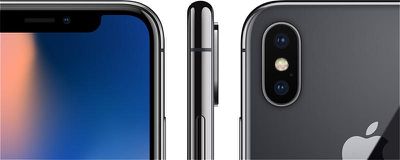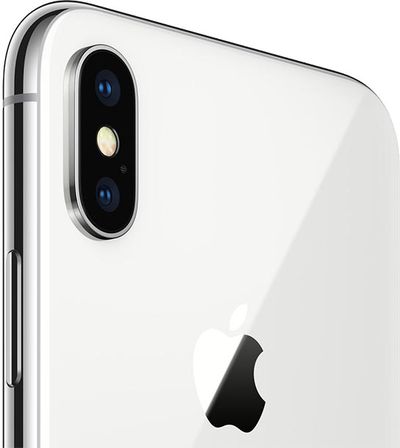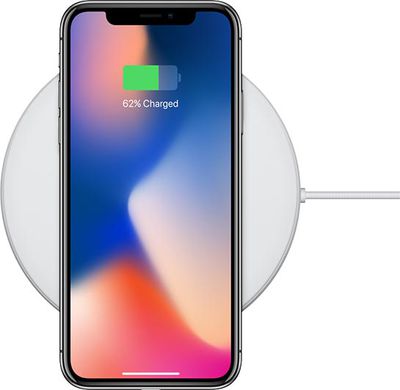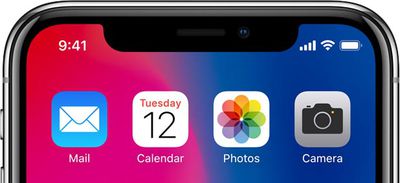Apple has officially introduced the iPhone X, its new flagship smartphone with dozens of new features. It won't be available until November 3, but here's a preview of 50 changes and improvements coming.

- Glass: iPhone X's front and back are all glass, with a strengthening layer that is 50 percent deeper. Apple said a seven-layer ink process allows for precise hues and opacity, and a reflective optical layer enhances the colors. An oleophobic coating helps reduce smudges and fingerprints.
- Stainless steel frame: A surgical-grade stainless steel band wraps around the edges of the iPhone X. It is an Apple-designed alloy.

- All-screen: iPhone X has a nearly edge to edge display with only a tiny notch at the top for the TrueDepth camera system. Thin bezels surround the display, and the Home button has been removed.
- Side button: Apple lengthened the Lock button and renamed it the Side button on iPhone X. Hold it to invoke Siri. Double click for Apple Pay.
- New accelerometer
- New gyroscope
- 5.8-inch display: The largest iPhone display ever. Nevertheless, the all-screen design allows it to be between an iPhone 8 and iPhone 8 Plus in both size and weight. For that reason, the iPhone X is the best choice for a smartphone with the maximum display size vs. one-handed usability.
- OLED: iPhone X is the first iPhone with an OLED display, which has benefits such as improved color accuracy, high contrast ratio, and true blacks.

- True Tone: iPhone X automatically adapts the color and intensity of the display to match the color temperature of the light in its surrounding environment. If you are standing in a dimly lit room with incandescent light bulbs, for example, the display would appear warmer and yellower. If you are standing outside on a cloudy day, the display would appear cooler and bluer.
- HDR: iPhone X has a true High Dynamic Range display. You can watch movies and shows in Dolby Vision and HDR10.
- 2436×1125 pixels: iPhone X has the highest resolution iPhone display ever. 458 pixels per inch.
- 1,000,000:1 contrast ratio
- Tap to Wake
- TrueDepth: The front camera system consists of an infrared camera, flood illuminator, proximity sensor, ambient light sensor, earpiece speaker, microphone, 7-megapixel camera, and a dot projector. It is used for Face ID facial recognition, Portrait Mode selfies, and Animoji.
- Face ID: Apple replaced Touch ID with Face ID on iPhone X. Simply raise the device, look at it, and swipe up on the screen to unlock the device or authenticate your identity for Apple Pay. Apple said there's a one in a million chance the facial recognition system could be duped by a stranger.
- Portrait Mode selfies: Portrait Mode is supported on the iPhone X's front-facing camera via the TrueDepth system.

- Animoji: Animoji are Apple's new set of emoji-style characters that animate based on an iPhone user's facial expression. Animoji take advantage of the iPhone X's new TrueDepth camera system, which features several new 3D sensors to detect your facial expressions in real time.
- Larger and faster 12-megapixel sensors
- Vertically-aligned dual lenses

- Dual optical image stabilization: iPhone X has optical image stabilization for both the wide-angle and telephoto lenses.
- Quad-LED True Tone flash with Slow Sync: Slow Sync combines a slow shutter speed with a short strobe pulse. It helps in low light when you want a brighter foreground subject with a properly exposed background. The flash's illumination is up to two times more uniform, helping to reduce hot spots.
- Improved image signal processor: Apple says its image signal processor detects elements in the scene—like people, motion, and lighting conditions—to optimize photos even before you take them. It also delivers advanced pixel processing, wide color capture, faster autofocus, and better HDR photos.
- Apple-designed video encoder: Real-time image processing with HEVC compression for reduced file sizes.
- 4K video recording at 60 FPS
- 1080p slo-mo video recording at 240 FPS

- Improved video stabilization
- Larger ƒ/2.4 aperture for telephoto lens: iPhone X's telephoto lens has a larger ƒ/2.4 aperture, which affects exposure and depth of field. By comparison, the telephoto lens on iPhone 7 Plus has a ƒ/2.8 aperture.
- Better low-light zoom
- Improved Portrait Mode
- Portrait Lighting: Apple says Portrait Lighting uses sophisticated algorithms to calculate how your facial features interact with light. Then it uses that data to create lighting effects, such as Natural Light, Studio Light, Contour Light, Stage Light, and Stage Light Mono.
- Calibrated for augmented reality
- Deeper pixels
- Wireless charging: iPhone X supports wireless charging based on the Qi standard. The device can charge by being placed on an inductive charging pad, such as Apple's upcoming AirPower mat or third-party options from accessory makers such as Mophie, Belkin, and Incipio.

- Fast charging: iPhone X is "fast-charge capable," which means the device can be charged to 50 percent battery life in 30 minutes using Apple's 29W, 61W, or 87W USB-C Power Adapters, sold separately and included with any 12-inch MacBook and 2016 or later MacBook Pro models.
- Longer battery life: Up to two hours longer than iPhone 7.
- A11 Bionic: Apple's latest chip has two performance cores that are 25 percent faster, and four high-efficiency cores that are 70 percent faster, than the A10 chip in iPhone 7 and iPhone 7 Plus.
- M11 motion coprocessor

- Neural engine: Apple says the neural engine in its A11 Bionic chip is a dual-core design that recognizes people, places, and objects. It processes machine learning tasks at up to 600 billion operations per second as the driving force behind new features like Face ID and Animoji.
- Faster Apple-designed GPU: Apple says its new three‑core graphics processor, part of the A11 Bionic chip, is up to 30 percent faster than the A10 Fusion chip in iPhone 7 and iPhone 7 Plus.
- NFC with reader mode: Apple recently introduced Core NFC, a new iOS 11 framework that enables apps to detect Near Field Communication tags.
- Bluetooth 5.0: Bluetooth 5.0 offers four times the range, two times the speed, and eight times the broadcast message capacity compared to Bluetooth 4.2.
- Galileo support: Galileo is Europe's Global Satellite Navigation System (GNSS), an alternative to the Global Positioning System (GPS) system owned by the United States government.
- QZSS support: Quasi-Zenith Satellite System is a satellite-based augmentation system for the Global Positioning System (GPS) that is receivable within Japan.
- Simplified status bar: Clock on the left. Wi-Fi strength, cellular bars, and battery life indicator on the right.

- Hold down Side button for Siri
- Press the Side button + Volume Up to take a screenshot
- Swipe up to close apps
- Swipe up and pause to view multitasking screen
- iPad-like dock design

- Selfie Scenes in Clips: When using Clips with an iPhone X, there's a new "Selfie Scenes" feature that will use the TrueDepth front-facing camera on the device to immerse users in a selection of 360-degree animated landscapes.
Design
Super Retina HD Display
Front Camera
Rear Camera
Power
Performance
Wireless
Location
iOS 11 on iPhone X
iPhone X can be ordered starting Friday, October 27, with in-store availability in limited quantities starting Friday, November 3.
The device is available in 64GB and 256GB storage capacities for $999 and $1,149 respectively in the United States. Prices vary elsewhere.































Top Rated Comments
I'm so happy with all of you apple bashers who won't be ordering the phone. That will make it easier for the rest of us to get one.
52) Impossible to find
53) Something-gate